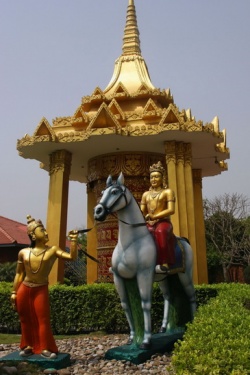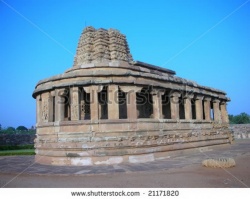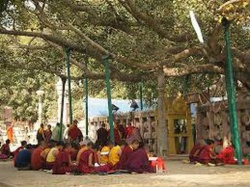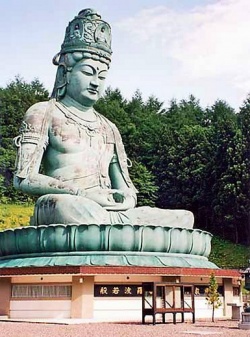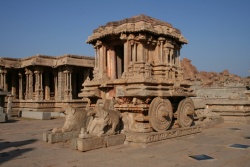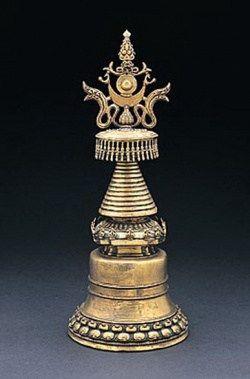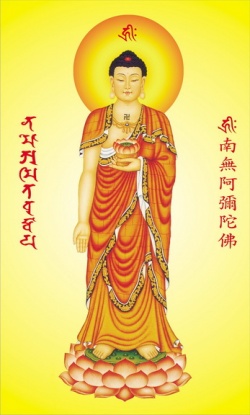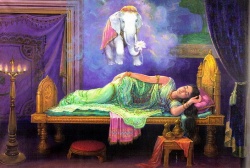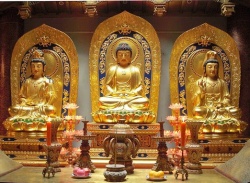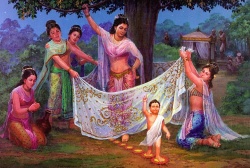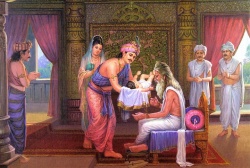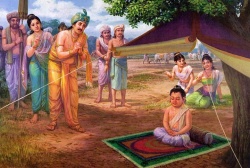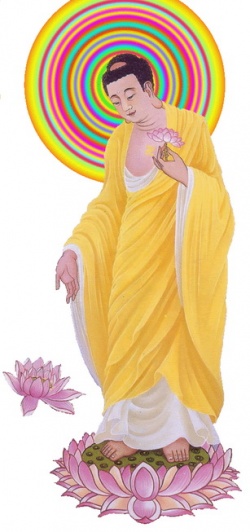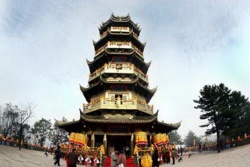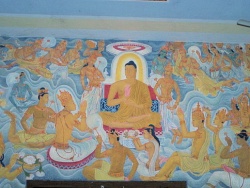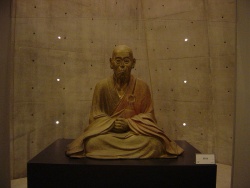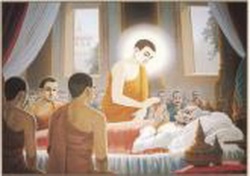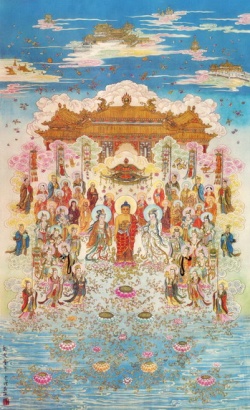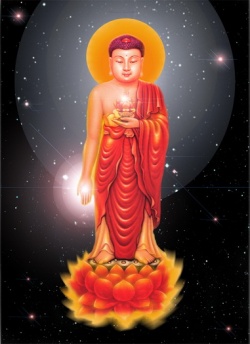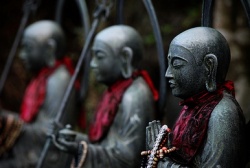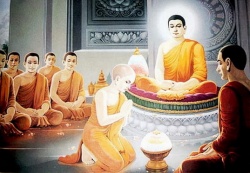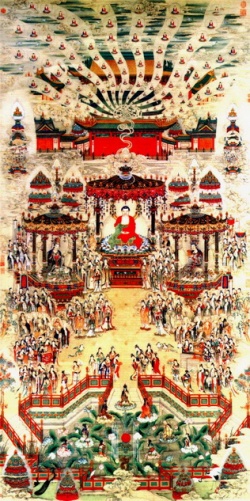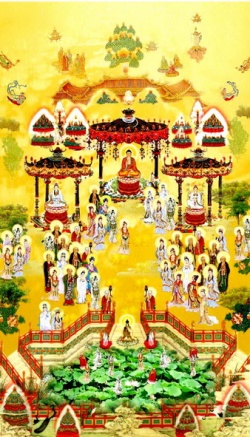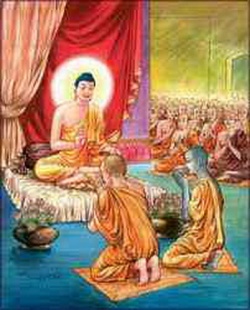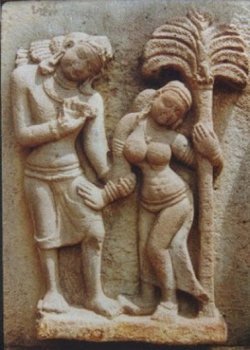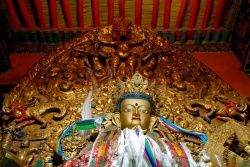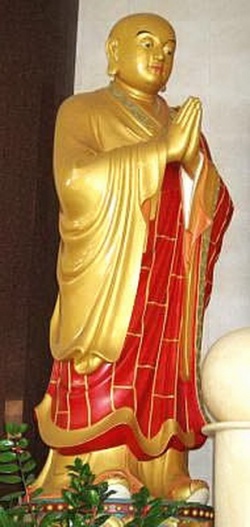Theories on the Foundation of the Nuns' Order – A Critical Evaluation
I. The Account of the Foundation of the Nuns' Order – Only a Product of the Sthavira tradition(s)?
According to the report given in the Pali Vinaya and in a discourse in the Anguttara-nikaya, during a visit paid by to his hometown Kapilavastu the Buddha was asked by Mahaprajapati Gautami to grant permission for women to go forth.1 Though she made her appeal for altogether three times, the Buddha each time refused her request. Once the Buddha had left Kapilavastu, Mahaprajapati Gautami cut off her hair, dressed in robes, and together with a group of like-minded Sakyan ladies followed the Buddha to Vaisali. At Vaisali, Ananda intervened on her behalf and convinced the Buddha to accede to Mahaprajapati Gautami's request. When permitting women to go forth, however, the Buddha predicted that the founding of an order of nuns would shorten the duration of his dispensation to five-hundred years.
The prediction that due to the coming into existence of an order of nuns the Dharma will last only five-hundred years recurs in the Vinayas of the Dharmaguptaka, 'Haimavata', Mahisasaka, and (Mula-)Sarvastivada traditions, preserved in Chinese translation.2 Though the Sarvastivada Vinaya does not give a full account of the foundation of the order of nuns, the same is described in a discourse in the Madhyama-agama collection,3 which is generally held to be of Sarvastivada provenance.4 Recurring also in a number of other texts,5 such a prediction is, however, absent from the Mahasamghika Vinaya brought by Fa-xian (法顯) from India.6
In the context of an examination of various predictions regarding the decline of the true Dharma, Nattier (1991: 32) notes that a prediction about the impending decline of the teachings within five-hundred years due to the founding of an order of nuns is not found "in the surviving literature of any of the Mahasamghika schools". She then concludes that "the idea of blaming the early demise of the Dharma on the nuns developed sometime after the initial sectarian division between the Sthavira and Mahasamghika schools, but before any further subdivisions within the Sthavira branch had taken place". The "date of the emergence of this tradition should therefore be placed during the period 340-200 BCE".7
Closer inspection of the Chinese version of the Mahasamghika Vinaya, however, reveals that this absence is merely a case of abbreviation, as this Vinaya refers to a more detailed account of Mahaprajapati Gautami's going forth preserved in a discourse.8 Besides the abbreviated reference in the Mahasamghika Vinaya preserved in Chinese, a Sanskrit version of the Mahasamghika-Lokottarvada Vinaya contains the full episode of the foundation of the order of nuns, and therewith also the reference to the diminished duration of the true Dharma, indicating that it will last for only five-hundred years, instead of a thousand.9
Thus the Buddha's refusal to allow women to go forth and his prediction that the founding of an order of nuns will shorten the life time of his teaching are elements also found in texts of the Mahasamghika tradition(s).
II. An Alternative Account in the Maitrisimit?
In addition to the accounts given in the various Vinayas, according to Laut (1991) an alternative description of how the order of nuns came into being can be found in the Maitrisimit, parts of which have been preserved in Uighur and Tocharian. Laut reports that in an Uighur version of this text Mahaprajapati Gautami tries to offer a robe to the Buddha out of gratitude for having received permission to go forth.10
The relevant part of the Maitrisimit, however, is merely an embellished version of the events described in the introductory section of the Dakkhi-navibhanga-sutta.11 The Dakkhinavibhanga-sutta, its two Chinese discourse parallels and a Tibetan version preserved as a sutra quotation in Samathadeva's commentary on the Abhidharmakosa record an occasion when Mahaprajapati Gautami, who apparently was a stream-enterer at the time of this event,12 tries to offer a robe to the Buddha, but is told that she should better offer it to the monastic community.
Laut concedes that the Maitrisimit does not explicitly refer to the foundation of the nuns' order, though according to him this should be understood to be implicit in the account, since going forth would be the necessary condition for Mahaprajapati Gautami's claim to have become a stream-enterer.13
Thus Laut's identification of this section in the Maitrisimit as an alternative account of the foundation of the order of nuns rests on his assumption that one needs to go forth in order to be able to attain stream-entry. A stream-enterer, he explains, is one who has reached the first level of the 'monastic' salvation career in Buddhism.14 His suggestion seems to confound the monastic sangha with the sangha of noble ones. Such confusion can easily happen, since whereas the early discourses describe recollecting the sangha in terms of the community of noble ones,15 the standard formula for taking refuge in the sangha speaks of the community of monks.16 Yet, these two types of sangha are not identical and they do not imply that one has to go forth to attain stream-entry, or even that those who have attained stream-entry need to go forth.
On the contrary, the early discourses report a number of cases where lay people attain stream-entry and even higher stages of awakening without going forth. A famous example would be the householder Anathapindika, who according to the canonical sources became a stream-entrant on his first meeting with the Buddha,17 but passed away after a life of devoted service to the monastic community while still being a layman.18 According to the Mahavacchagotta-sutta and its Chinese parallels, quite a substantial number – "over five-hundred" – of lay disciples of the Buddha had progressed considerably further on the path to awakening by reaching the stage of non-returning.19 Not only non-returning, but even full awakening appears to have been within reach of the laity, as the case of Yasa suggests, who apparently went forth only after having become an arahant. 20
Thus the attainment of stream-entry does not require going forth and these two events can take place quite independent of each other. In fact, the Maitrisimit repeatedly refers to Mahaprajapati Gautami as "queen" or "lady",21 which suggests that, at least from the perspective of this text, she was still a lay-woman when she attempted to offer a robe to the Buddha. This is not the case for all versions of this event, as one record of her attempt to offer a robe to the Buddha, preserved in Chinese translation, explicitly introduces her as a nun.22 Whether she was a nun at the time of attempting to donate a robe to the Buddha or not, her attainment of streamentry does not stand in any particular relation to the foundation of the order of nuns, hence the Maitrisimit does not provide an alternative account of how the order of nuns came into existence.
III. Nuns Before Mahaprajapati Gautami's Going Forth?
Mahaprajapati Gautami 's attempt to offer a robe to the Buddha has been the basis for yet another hypothesis, based on the account of this offer given in the Dakkhinavibhanga-sutta. Williams (2000: 169) notes that according to the earlier part of this discourse Mahaprajapati Gautami "keeps the five precepts. This clearly implies that this is meant to have taken place before she was part of the Sagha, members of which adhere to ten precepts for novices, and many more for those who had taken higher ordination ... she is thus depicted as a lay person".
For her to be a laywoman, however, conflicts with a listing of recipients of gifts in a later part of the Dakkhinavibhanga-sutta, which mentions gifts given to bhiksunis. If at the time of this discourse Mahaprajapati Gautami had not yet gone forth, a reference to other nuns would be an anachronism, as according to the canonical accounts of the foundation of the nuns' order she was the first nun in the Buddha's dispensation. Williams (2000: 170) concludes that "it would seem ... that this is evidence of the existence of bhikkhunis before Mahapajapati requested the going forth".23 Williams also envisages an alternative explanation, according to which "this sutta may be an assimilation of one story with another".24
Closer examination of the Dakkhinavibhanga-sutta suggests that Mahaprajapati Gautami 's status as a lay woman is not as unequivocal as Williams assumes. The reference to the five precepts comes as part of a description of her taking refuge and becoming a disciple of the Buddha, a description that employs past participles.25 Thus this passage appears to be a report of her becoming a lay disciple at an earlier point of time, without thereby necessarily intending that at the time of the Dakkhinavibha nga-sutta she was still observing only the five precepts.
Besides, the monastic rules appear to have come into existence only in a gradual manner, being laid down as and when occasion demanded.26 Depending on how early Mahaprajapati Gautami's attempt to offer a robe to the Buddha should be placed,27 the contrast between the five precepts undertaken at the moment of becoming a disciple of the Buddha and the full set of monastic rules to be observed by bhikkhus and bhikkhunis may not yet have been in existence.
Regarding the gift of a robe, a stipulation found in the different Vinayas makes such a gift allowable if it comes from a monastic who is a relative. 28 Whether this regulation was in existence already at the time of Gautami's offer or not, it would thus have been possible for her to try to offer a robe to the Buddha while being a nun.
Thus, although the early part of the Dakkhinavibhanga-sutta reads more naturally if one assumes that Gautami was still a lay woman, it does not offer unambiguous proofs in support of such a conclusion. Besides, as already mentioned above, one of the Chinese parallels to the Dakkhinavibha nga-sutta explicitly introduces Mahaprajapati Gautami as a nun, so that here the reference to having taken the five precepts is made in relation to bhiksuni Mahaprajapati Gautami.29 According to this version at least, her attempted offer of a robe took place after she had gone forth and thus without creating any anachronism in regard to the inclusion of nuns in the listing of recipients of gifts in the same discourse.
If the Dakkhinavibhanga-sutta is nevertheless perceived as involving an anachronism, then this need not imply that nuns were in existence before Mahaprajapati Gautami went forth. Such a conclusion would not only conflict with the account of the foundation of the order of nuns in the different Vinayas and in several canonical discourses, but also with the listing of eminent disciples in the Anguttara-nikaya and in the Ekottarikaagama, which agree on presenting her as outstanding among the nuns due to her seniority.30 For Mahaprajapati Gautami to be accorded this particular rank implies that she was indeed the first nun to receive ordination, which would also fit in naturally with her recurrent role in the different Vinayas as a spokeswoman on behalf of the nuns.
Though the Dakkhinavibhanga-sutta and its parallels combine Gautami's attempt to offer a robe to the Buddha with a detailed listing of recipients of gifts, this is not the case for all records of this particular meeting between her and the Buddha.31 This suggests the possibility that the account of the attempted offer of a robe to the Buddha and the description of recipients of gifts might originally have been two separate textual pieces. During the course of oral transmission these two parts could then have been combined to form a single account, a combination that would have to have happened early enough in order to affect the Dakkhinavibhangasutta of the Majjhima-nikaya and its parallels.
Such combining of textual pieces of different provenance is not an uncommon feature for literature that has been orally transmitted over longer periods of time. In the Majjhima-nikaya itself, several discourses appear to have incorporated material that seems to stem from different contexts, or even from what originally might have been commentarial explanations. 32
Thus the second of the two alternative explanations suggested by Williams (2000: 170), according to which what appears like an anachronism in the Dakkhinavibhanga-sutta could be explained as the outcome of a merger of two originally different texts, seems to offer a relatively straightforward solution. In contrast, hypostatizing an existence of nuns before Mahaprajapati Gautami went forth would not be based on unequivocal evidence from the Dakkhinavibhanga-sutta, it would be contradicted by one of the Chinese parallels to this discourse, and it would conflict with a broad range of other canonical sources transmitted by different Buddhist traditions regarding Mahaprajapati Gautami's role in relation to the foundation of the order of nuns.33
IV. The Nuns' Order Founded only after the Buddha's Demise?
Whereas Williams envisages the possibility that Buddhist nuns existed earlier than generally assumed, von Hinüber (2008) holds that Buddhist nuns may have come into existence at a considerably later date. Based on what he believes to be a case of outside influence on the wording in the Bhikkhunivibhanga of the Pali Vinaya, he comes to the conclusion that the order of nuns appears to have been founded only after the Buddha had passed away.
His proposal rests on several premises and thus requires a more detailed discussion than the theories examined so far. The essential aspects of his proposition can be summarized in four sections, which cover: (1) the occurrence of the expressions vutthapeti and pavattini in the Bhikkhunivibhanga; (2) the Buddha's contacts with nuns in the four Pali Nikayas; (3) a comparison with the position of nuns in the Jaina tradition; and von Hinüber's hypothesis (4) on how the order of nuns would have come into being. I will examine each of these points in turn.
1) The Expressions Vutthapeti and Pavattini
Von Hinüber (2008: 17) notes that, instead of the term upasampadeti, the Bhikkhunivibhavga uses vutthapeti to designate the ordination of nuns. The same text also employs the term pavattini to refer to a nun's teacher, instead of upajjhaya.34 To explain this departure from the terminology used for monks, von Hinüber (2008: 19) suggests that "the vocabulary of the ordination of nuns must have come from outside Buddhism".
The case of vutthapeti replacing upasampadeti has already been discussed at length by Shih (2000: 345-405).35 According to her explanation, "vutthapeti and upasampadeti ... represent different stages in the two-tiered ordination procedure. Only monks can give ordination (upasampada) to a candidate, nuns cannot, so the functioning of each Sangha needs to be verbally differentiated. That is why vutthapeti is used consistently instead of upasampadeti for nuns" (2000: 375-376). That is, terminology specific to the nuns would in itself not be surprising, as it might simply reflect particulars of their situation.
Whatever may be the final word on the significance of vutthapeti and pavattini, von Hinüber is certainly correct in pointing out that these two terms are instances of terminological similarities between the Buddhist and the Jaina traditions. Regarding such terminological similarities in general, however, there would be no a priori reason why these should imply a borrowing on the Buddhist side.
In the case of another term common to both traditions, Tieken (2001: 586) comes to the conclusion that it seems as if the "Jainas borrowed the word directly from the commentaries on the Pali Vinaya", adding that "the Buddhist influence would in fact have gone very deeply, as we are dealing with a word here which is very common in the Jaina canon".
Tieken (2001: 585) notes that the traditional account "sets the compilation of the present Jaina canon approximately one thousand years after Mahavira's death", concluding that "it would seem that we have to take the tradition of the Jainas concerning the origin of the canon seriously" in the sense that the Jaina "canon might well be a relatively late compilation" (2001: 586).
In other publications, von Hinüber himself explains that the language of the Jainas tends to be closer to late and post-canonical Buddhist literature than to the older layers of the Pali canon;36 and in relation to the formulation of a particular rule for monks, he envisages the possibility that the Jainas may have been borrowing from the Buddhists.37
Thus it is not self-evident that in the present case the Buddhists borrowed terms like vutthapeti and pavattini from the Jainas, since it cannot be excluded that the Jainas loaned such terms from the Buddhists, or else, perhaps the most probable suggestion, it may well be that both traditions drew on vocabulary current among ascetic circles in ancient India.
Even in case the Buddhists should have borrowed these terms from the Jainas – which is by no means certain – in view of the fact that the Jaina tradition was already in existence before the advent of Buddhism, such borrowing could have happened at any time. That is, there seems to be no particular reason why terminology like vutthapeti and pavattini should be of a later origin than upasampadeti and upajjhaya. All such terms would derive from vocabulary common in ancient India, and the same source of ancient Indian terminology could have been responsible for the terms used in relation to the order of monks as well as for those employed in relation to the subsequently founded order of nuns.
Von Hinüber (2008: 26), however, takes the terms he has highlighted in the Bhikkhunivibhanga to be late, since "historical events such as the foundation of both communities, monks and nuns, could be transmitted to later generations only by the means of expression available at the time". Yet, if the order of nuns had indeed come into existence only after the Buddha's demise, those who would have faked the canonical accounts of the foundation of the order of nuns could simply have copied the terms from the Bhikkhuvibhanga, instead of using different terms. This would, in fact, be the more probable procedure, since the forger(s) of an account to be passed off as canonical would of course keep as close as possible to the corresponding passages in the Bhikkhuvibhanga, in order not to give themselves away.
Employment of the same terminology as found in the Bhikkhuvibhanga would also be more probable in view of the natural tendency of oral transmission towards levelling and uniformity, evidenced in the circumstance that, as noted by von Hinüber (2008: 17), "vutthapeti found in the Patimokkha for nuns disappears in the Cullavagga". As von Hinüber (2008: 19) explains, in this way "the term vutthapana was replaced by upasampada in the Khandhaka", "following the model of the terminology used in the rules for monks". Thus the occurrence of specific terminology like vutthapeti and pavattini could even be taken to point to the authenticity of the Bhikkhunivibhanga.
In sum, there seems to be no need to assume that the occurrence of vutthapeti and pavattini in the Bhikkhunivibhanga points to a coming into existence of the order of nuns at a time when the Buddha had already passed away.
2) The Buddha's Interaction with Nuns
Von Hinüber (2008: 21) highlights that "the Buddha is never mentioned as talking to any individual nun in the four Nikayas of the Suttapitaka". He further notes that "when the Buddha dies, no nun is present, only monks and gods. This is of considerable importance, because it is extremely difficult to imagine that it could have been possible to distort the report on the nirvana and introduce or delete persons witnessing this event". "Thus while the Buddha only talks about nuns or receives reports on nuns occasionally ... he never talks to individual nuns in any text of the four Nikayas" (2008: 22).
From a methodological perspective, it remains unclear to me why in a "contribution to the earliest history of Buddhism" – this being the title of von Hinüber's article – 'talking to individual nuns' is singled out as the only relevant type of interaction between the Buddha and the nuns. Once the canonical material is taken seriously as a potential source of historical information, which von Hinüber seems willing to do, then all instances where nuns are shown to be in some relation to the Buddha should be of relevance. That is, any hypothesis about the non-existence of nuns during the Buddha's life time would also need to take into account records of the Buddha speaking to a group of nuns, the Buddha speaking about individual nuns, the Buddha speaking about a group of nuns, individual nuns speaking to the Buddha, a group of nuns speaking to the Buddha, and even reports about an individual nun or a group of nuns given by someone else to the Buddha. All such instances would conflict with the assumption that the order of nuns came into being only when the Buddha had already passed away.
This methodological problem of basing a hypothesis on an adequate examination of the sources becomes further aggravated by the circumstance that, in order to reach conclusions about the history of early Buddhism, a study of all relevant sources is an indispensable requirement. For conclusions of such significance, attempting a major revision of the history of early Buddhism, it is not possible to restrict one's research to the four Pali Nikayas alone. In the Pali canon itself, the Therigatha certainly deserves to be reckoned as relevant source material at least on a par with Nikaya passages such as the Mahaparinibbana-sutta.38 The same applies to any contact between the Buddha and nuns reported in the Vinaya.39 Of even greater importance would be extending the research beyond the confines of the Pali canon, as the Chineses Agamas and Vinayas definitely need to be considered, together with relevant material preserved in Tibetan. Given that we do not possess archaeological or epigraphic material on the foundation of the order of nuns and thus have to rely entirely on textual records – with all the problems that this entails – it is all the more imperative that the extant textual records are used in as comprehensive a manner as possible.
In the present case, the Chinese Agamas are taken into consideration by von Hinüber on one occasion,40 when in relation to the Dakkhinavibhanga-sutta he remarks that "L. Schmithausen draws my attention to the remarkable fact that some Chinese versions correctly preserve a most likely older version of the text without any reference to the nuns" (2008: 21 note 59). This is not correct, as the two Chinese parallels to the Dakkhinavibhanga-sutta refer repeatedly to the nuns.
Von Hinüber apparently misunderstood a remark made by Schmithausen to the effect that while a particular phrase in the Pali version speaks of a gift given to "the two communities headed by the Buddha", the corresponding phrase in the Chinese parallels speaks only of a gift given to "the community of monks headed by the Buddha", as is also the case for a Tibetan version preserved as a sutra quotation in Samathadeva's commentary on the Abhidharmakosa.41 The Pali, Chinese and Tibetan versions agree, however, on mentioning gifts given to the community of nuns,42 or gifts to a group of nuns, etc.
Though von Hinüber is certainly right in highlighting that the canonical sources refer less frequently to nuns than one would have expected, a background for appreciating why nuns were not present when the Buddha passed away could be gathered from several Vinaya rules. These rules reveal that close association between monks and nuns was prone to lead to criticism and to suspicions that they might be having amorous relations. To avoid such suspicions and criticism, according to regulations recorded similarly in the different Vinayas, monks were not allowed to set out travelling together with nuns, or to embark with them in the same boat, in fact a monk should not even teach nuns late in the evening.43 Evidently, contacts between nuns and monks were a delicate matter.
Not even the Buddha himself appears to have been above such suspicions. The Pali Udana collection reports that the female wanderer Sundari was killed and her body buried in Jeta's Grove in order to discredit the Buddhist monks.44 According to the commentary on the Dhammapada, this defamation was specifically aimed at the Buddha, insinuating that he had taken his pleasure with Sundari, after which his disciples had killed and buried her in order to hide the misdoings of their teacher.45 A similar tale is also found in the Chinese counterpart to the Atthakavagga of the Sutta-nipata.46 The commentary on the Bahitika-sutta indicates that this defamation even motivated king Prasenajit to question Ananda on the moral integrity of the Buddha, an inquiry also reported in the Chinese parallel.47 The tale about Sundari's murder appears to have been well known throughout generations of Buddhists, as the travel records of the Chinese pilgrims Fa-xian (法顯) and Xuan-zang (玄奘) refer to the place where she had been buried in Jeta's Grove.48
Another tale recorded in the Pali tradition involves a female wanderer by the name of Ci–ca-manavika, who feigned being with child and accused the Buddha of being responsible for her pregnancy.49 A similar story recurs in the (Mula)-sarvastivada Vinaya and in the Chinese Udana collection, 50 and in this case, too, Fa-xian (法顯) and Xuan-zang (玄奘) knew a version of this story.51
Independent of whatever historical value one may assign to these stories, 52 they do reflect ancient Indian concerns about relations between celibates and the other sex. Such concerns make it only natural for the Buddha to not set out wandering in the company of nuns.
This would make it more easily understandable why the canonical sources frequently report that the Buddha addresses monks, who would regularly have been with him on his wanderings. Due to his wandering life style, contacts with nuns would naturally have been less frequent. The same would also explain why at the time of the Buddha's passing away nuns were not present, simply because they did not accompany him on his wanderings. Thus they stood little chance of being present when he suddenly fell ill and passed away while being in the midst of one of his tours of the country.
Yet, even taking into account that relations between the Buddha and the nuns would naturally have been considerably less than with monks, the relative dearth of passages that record the Buddha directly speaking to nuns remains remarkable.
However, references to the Buddha directly speaking to nuns are not entirely absent from the four Pali Nikayas. In addition to a discourse in the Sayutta-nikaya, according to which the Buddha delivered a discourse on the nature of a stream-enterer to a group of one-hundred nuns,53 a discourse in the Anguttara-nikaya reports how the Buddha gave a succinct instruction on the chief principles of the Dharma to Mahaprajapati Gautami, when they were both at Vaisali.54 This discourse is thus located at the same venue where according to the canonical account the order of nuns was founded, which suggests that she may already have been a nun. In fact, her request to be given an instruction in brief for intensive solitary practice employs a pericope used elsewhere in the Pali discourses consistently by monastics.55 The impression that Mahaprajapati Gautami would have been a nun at the time of the delivery of this discourse is further strengthened by the circumstance that the Buddha replies to her request by recommending the development of a set of qualities, one of which is that she should be "easy to support", subhara, instead of being "difficult to support", dubbhara.56 These qualities would refer to the relationship between a monastic and his lay supporters, in fact elsewhere in the four Pali Nikayas these terms recur in explicit relation to a monastic.57 Thus the location, the formulation of her request and the phrasing of the Buddha's reply make it highly probable that she was already a nun at the time of this discourse.
Besides, the fewness of reports where the Buddha directly addresses nuns could be a characteristic of the Theravada tradition in particular. Roth (1970: xl) notes that according to the description of the promulgation of rules for nuns in the Mahasamghika-Lokottaravada Vinaya, Mahaprajapati Gautami regularly approaches the Buddha to personally report any case of misconduct to him. In the Theravada Vinaya such cases happen only rarely,58 as here the role of reporting a matter to the Buddha is usually taken by the monks instead, who have been informed about what has happened by the nuns. In the Dharmaguptaka, Mahisasaka, (Mula-)Sarvastivada and Sarvastivada Vinayas such meetings between Mahaprajapati Gautami and the Buddha occur more regularly.59 Thus in this respect the Theravada Vinaya seems to stand out as the version that reports the least number of direct contacts between Mahaprajapati Gautami and the Buddha.
The same pattern seems to also manifest in the Pali Nikayas. An example would be the Nandakovada-sutta, where von Hinüber (2008: 24) rightly highlights that the Buddha, on being asked by Mahaprajapati Gautami to instruct the nuns, "does not even talk to her".60 The same is not the case in a Chinese parallel, in a Sanskrit fragment parallel, and in a sutra quotation found in the (Mula-)Sarvastivada Vinaya, preserved in Chinese and Tibetan. All these parallel versions agree in reporting that the Buddha personally gave teachings to Mahaprajapati Gautami and to the nuns who had come together with her.61
A similar instance is the Culavedalla-sutta, where in the Pali version the nun Dharmadinna does not have any direct contact with the Buddha. In the Chinese counterpart, she personally speaks to the Buddha, a circumstance also reported in a Tibetan version of this discourse preserved as a sutra quotation in Samathadeva's commentary on the Abhidharmakosa.62
In addition to this apparent tendency in Theravada texts of minimizing contacts between the Buddha and nuns, it also needs to be taken into account that at times references to monks in Pali discourses may implicitly include the nuns. A case in point can be found in the Yuganaddha-sutta, which depicts four ways in which "monks or nuns" may reach full liberation. Even though these four ways are introduced by explicitly mentioning the nuns alongside the monks, the actual treatment of each individual way only speaks of monks, and the nuns are only mentioned again in the concluding statement.63 Since the introductory and concluding statement, as well as the matter at hand, make it clear that the same four ways also apply to nuns, the usage of the term bhikkhu in the actual treatment clearly does not intend to restrict the exposition to monks alone, but rather acts as an umbrella term that includes the nuns as well. A parallel discourse in the Sayukta-agama is more consistent in this respect, as here the nuns are mentioned not only in the introductory and concluding statement, but also in the actual treatment of the four ways of reaching liberation.64
A similar pattern can be observed in the case of the Cetokhila-sutta of the Anguttara-nikaya, where again the general statements found in the introductory and concluding sections speak of monks and nuns, whereas the actual treatment only refers to monks.65 Since the discourse lists mental obstructions that prevent spiritual progress, here too it seems safe to presume that the treatment given is not meant to be of relevance to monks alone. Two Chinese parallels, found in the Madhyama-agama and the Ekottarika-agama, also mention the nuns.66 A version of the Cetokhilasutta found in the Majjhima-nikaya, whose exposition of these mental obstructions is in other respects similar to the Anguttara-nikaya version, does not mention the nuns at all.67
These instances suggest that the absence of references to the Buddha directly conversing with nuns, or any lack of explicit mention made of nuns, may be characteristic of the Theravada reciters in particular. This further highlights the methodological problem mentioned above, since restricting the range of sources to the four Pali Nikayas necessarily results in a partial picture. This can only be rectified when all available sources are taken into account.
The methodological problem of adequate examination of sources can also be demonstrated with cases like the Nandakovada-sutta or the Culavedalla- sutta, since these discourses are testimonies to contact between the Buddha and the nuns in all versions, including the Pali accounts. It is only when the frame of examination is narrowed down to instances where the Buddha directly addresses an individual nun, that even the information provided by the Pali discourses is lost sight of.
3) Comparison with the Jaina Tradition
Von Hinüber (2008: 24) compares his assessment of the attitude towards nuns in early Buddhism with "the very different attitude to nuns reflected in Svetambara Jaina texts", where "Mahavira himself personally communicated with the chief nun Candana". He further notes that "in contrast to Buddhism, there is neither any trace of reluctance to accept nuns nor are there separate sets of rules for monks and nuns in Svetambara Jainism".
Von Hinüber's reference to a particular occasion where "Mahavira himself personally communicated with the chief nun Candana" appears to be based on a misreading. Von Hinüber bases himself on Schubring,68 yet the relevant passage in Schubring only indicates that Mahavira brought his 'mother' Devananda to Ajja Candana, without mentioning any form of communication.69 The corresponding passage in the Viyahapannatti, the source text referred to by Schubring, just reports that, after having himself given the going forth to his 'mother',70 Mahavira personally handed her over to Ajja Candana.71 Thus this particular instance does not record any "personal communication between Mahavira and Candana" and would fall short of fulfilling the criteria von Hinüber applies to Buddhist texts, where he only considers instances to be relevant if they record a direct communication between the Buddha and an individual nun.
Regarding contacts between Jaina nuns and Mahavira in general, if we are to believe the Jinacaritra, Mahavira's nun disciples more than doubled their male counterparts.72 Yet, the scriptures of the Jaina canon do not give nuns the prominent place one would have expected in the light of such figures, as their occurrence, or even references to them, fall far behind the ratio given in the Jinacaritra. Thus a perusal of Jaina texts gives the impression as if the same pattern may have been operative in Jaina and in Buddhist texts, in that the degree to which nuns occur in the respective canons probably reflects the predilection of the male reciters more than actual historical conditions.
In relation to personal contact between the nuns and Mahavira, it is instructive to turn to the Antagada-dasao (Antakddasa), the eigth anga of the Jaina canon. This work contains a series of legends of saints, depicting their life from the time before their conversion until their final fast to death. According to Jaina customs, permission from one's teacher is required before beginning such fasting to death. In the case of monks, the Antagada-dasao reports that such permission was personally given by the leader of the community, Mahavira or Aristanemi, one of his predecessors. 73 But when describing such action undertaken by nuns, the last chapter of this work reports that such permission is requested from and then given by Ajja Candana.74 Thus here, too, a canonical text gives the distinct impression that the nuns did not have the same type of personal contact with the leader of the community as the monks.
Another instance of interest is the tale of a female predecessor of Mahavira by the name Malli, whose story is narrated in the Nayadhammakahao (Jnatadharmakatha), the sixth anga of the Jaina canon. The Svetambara version of this tale describes Malli's youth as a princess and her renunciation. Roth (1983: 48) notes that during the later part of this description, beginning with the moment that she is qualified as an arhat, the text switches to employing masculine forms to refer to Malli, even though she is still a woman.75 The Digambara version of this tale, then, speaks from the outset of male Malli instead, describing 'his' youth as a prince, 'his' going forth and 'his' awakening.76
The shift from female Malli to male Malli reflects the view, firmly held by the Digambara Jains, that women are by nature incapable of attaining liberation.77 According to Schubring (1962: 61), a Jaina work by the title Chappahuda even goes so far as to conclude that, given that women cannot reach liberation, there should be no nuns at all.
Though such doubts about women's capabilities to reach liberation need not have been in circulation already at the time of Mahavira and the Buddha, they nevertheless stand in stark contrast to the early Buddhist attitude, where the canonical texts clearly acknowledge women's ability to attain all four stages of awakening, something mentioned explicitly in several canonical accounts of the foundation of the order of nuns.78 Turning to the next point raised by von Hinüber, he notes that the Jaina texts do not report any "reluctance to accept nuns". Given that we do not have an account of the foundation of the Jaina order of nuns, it would be difficult to come to a conclusion regarding the presence or absence of any reluctance when the Jaina order of nuns was founded.
Regarding the formulation of rules, in the sense that according to von Hinüber there are no "separate sets of rules for monks and nuns in Svetambara Jainism", it seems uncertain to what degree such formulations can be taken as indicators of an equal treatment of monks and nuns. It could just as well be assumed that the Buddhist nuns are given more importance by having rules addressed to them individually, instead of just being included in the rules formulated for monks.
Besides, according to Deo (1956: 501) the monastic regulations of the Digambara Jains tend not to mention nuns at all, leave alone treating them on a par with monks. Even in the case the Svetambara Jains, the difference between their mode of presenting rules for nuns and the Buddhist monastic regulations is perhaps not as clear-cut as might seem at first sight. For example the Vavahara (Vyavahara), one of the Cheda-sutras of the Svetambara canon and thus a text of central importance for Jaina monastic discipline, presents some rules for monks and nuns separately, in subsequent chapters of its treatment, even though the actual formulation of these rules – except for replacing masculine forms with their feminine counterparts – is the same.79
Moreover, closer inspection brings to light rules that do not breathe a spirit of equality. Thus two rules in the Vavahara stipulate that a nun can ascend to the position of upadhyaya after having been ordained for thirty years, while she can become an acarya-upadhyaya once she has completed sixty years; in contrast, a monk needs to only have been ordained for three years to become an upadhyaya and after five years he can take up the position of an acarya-upadhyaya.80 This corroborates the observation by von Glasenapp (1999: 376) that in Jainism "the rules for nuns in parts are stricter than those for monks".81 Thus it seems as if Jaina nuns may not have fared substantially better in this respect than Buddhist nuns, who have to observe more rules than their male counterparts.
Jain (1947: 153) explains that Jaina nuns were not allowed to study certain texts, the reasoning being that "women are not strong enough and are fickle-minded". Such a restriction does not appear to be known from the early Buddhist traditions. According to Balbir (2002: 70), "except in recent times ... Jain women have not been able to speak for themselves: almost all the texts we have inherited from the past are written by monks or are male-oriented, and no really innovative dogmatic treatise is known to have been composed by any woman of the tradition". A contrast to this could be provided with the example of the collection of verses by Buddhist nuns, the Therigatha.82
In sum, instead of a substantially better position of nuns in the Jaina tradition, compared to Buddhist nuns, the above survey suggests that ancient Indian negative attitudes towards women in general and nuns in particular had their impact on both traditions.
4) The Order of Nuns Founded after the Death of the Buddha?
Von Hinüber (2008: 27) introduces his conclusions by stating that, "taking all the evidence preserved in the texts together ... it is not easy to avoid the conclusion that the introduction of the order of nuns was indeed an event at the end of the period of early Buddhism, not too long after the death of the Buddha".
Due to restricting himself to the four Pali Nikayas and confining his evidence to instances where the Buddha speaks to individual nuns, von Hinüber's conclusions do not "take all the evidence preserved in the texts together" into account. Once a text like the Mahaparinibbana-sutta is treated as a reliable source of historical information (about the absence of nuns on the occasion of the Buddha's decease), the same status would have to be accorded to the range of other discourses that document the existence of the order of nuns during the Buddha's life time.83
Though this methodological shortcoming already suffices to vitiate the proposed theory, it may nevertheless be worthwhile to follow up the implications of von Hinüber's proposal. On the assumption that the Buddha did not found an order of nuns, it is difficult to conceive of anyone who could have started an order of nuns once the Buddha had passed away, just as it is hard to imagine how anyone could successfully have carried out such a revolutionary action as founding an order of nuns on his or her own.
Regarding the 'how' of such an innovation, since tradition attributes the origin of all Vinaya related actions to the Buddha, an innovation of such magnitude, without having a precedent in a permission or legislation by the Buddha, would have faced insurmountable obstacles as long as the early generations of disciples, especially his faithful attendant Ananda, were still alive. Their regard for their deceased teacher would have been too strong to allow them to embark on something they knew the Buddha had consistently opposed. The accounts of the so-called first council clearly reflect a move towards traditionalism – expressed in the narration that the rules, whose abolishing the Buddha had sanctioned, were not abandoned – making an innovation of such a magnitude a highly improbable event.84
Even to put such a move into operation in later times would have been exceedingly difficult, and the greater the time distance from the Buddha's lifetime becomes, the more difficult it would be to successfully canonize such an act in the orally transmitted texts of different Buddhist schools. Von Hinüber (2008: 25) assumes that "the Buddhists ... had to give in to some sort of social pressure from outside ... and were forced ... to establish an order of nuns". He gives no reference for this suggestion, in fact it would be difficult to provide support for the notion of a social pressure in ancient India in favour of establishing an order of nuns.
Given that the Vinayas portray the Buddha as someone willing to lend an ear to general opinion, had such social pressure been in existence during his life time, it would run counter to his character portrayal in the canonical sources to assume that he did not lend an ear to it. If, however, we assume that such social pressure came into being only afterwards, then the supposed foundation of the order of nuns would have to be placed at a considerable temporal distance from the Buddha's life time in order for such social pressure to come into existence and build up to a level sufficiently strong to exert its influence.
Besides, the assumption of a social pressure in favour of founding an order of nuns after the Buddha's life time does not fit too well with the little we know about the ancient Indian situation. While several texts point to some degree of spiritual freedom for women during Vedic and early Upaniadic times,85 their position seems to suffer a gradual decline until it reaches an absolute low with the Manusmti. Thus the further we advance in time, the less one would expect public opinion to be in favour of establishing an order of nuns. This, too, makes it highly improbable that any faction in the Buddhist community would have been motivated to undertake such an innovation, let alone have been able to carry it through.
Regarding the 'who' of such an innovation, tradition unanimously presents Mahaprajapati Gautami as the foster mother of the Buddha. This implies that she would have been considerably older than him, in fact several texts report that she passed away before the Buddha.86 Had she still been alive, then by the time of the Buddha's passing away she would have been a centenarian at least, making her an improbable candidate for starting an order of nuns at a still later time. Yet, this seems to be what von Hinüber (2008: 20) has in mind. After noting that when Mahaprajapati Gautami approaches the Buddha at Vaisali, "Gotami and all the Sakiyanis look like a group of female ascetics with their leader", he suggests that "the particular vocabulary in the rules for nuns can be explained easily as remnants of the peculiar linguistic usage of these female ascetics in their own rules at the time before they converted to Buddhism". Von Hinüber (2008: 21) continues by referring to this "group of female ascetics joining Buddhism", concluding that "the sagha of nuns is created by accepting the whole group of ascetics accompanying Mahapajapati Gotami."
Thus here Mahaprajapati Gautami and her following of Sakyan ladies, because a canonical passage describes them as resembling female ascetics, are turned into actual female ascetics that have gone forth under a non - Buddhist teacher, who would have taught them the vocabulary that they are going to introduce into the Bhikkhunivibhanga.
To draw out the implication of this hypothesis: after her initial request to be allowed to become a Buddhist nun has met with the Buddha's refusal, Mahaprajapati Gautami – who as a stream-enterer would have been unable to follow a non-Buddhist teacher87 – goes forth as a nun under a non- Buddhist ascetic, together with her following of Sakyan ladies. Once the Buddha has passed away, Mahaprajapati Gautami manages to transform herself and her following of female ascetics into Buddhist nuns, which earlier was not possible because of the Buddha's refusal. Nobody is able to stop them from doing something that everyone knew had not been sanctioned by the Buddha. Those sympathetic with her action devise a canonical account of the foundation of the nuns' order that attributes this innovation to the Buddha himself, an account that is then successfully inserted in the Vinayas and other canonical scriptures of the different Buddhist school. The only trace left of this amazing feat is the occurrence of the terms vutthapeti and pavattini in the Bhikkhunivibhanga, originating from the non-Buddhist rules that Mahaprajapati Gautami and her followers had been observing during their intermezzo as non-Buddhist ascetics.
This hypothesis thus involves the assumptions that:
a) the Buddha remained firm in his refusal to found an order of nuns;
b) Buddhist women who wanted to go forth thereon decided to do so under a non-Buddhist teacher;
c) social pressure was in favour of having an order of nuns among Buddhists;
d) at some time after the Buddha had passed away, these non-Buddhist female ascetics decided to transform themselves into Buddhist nuns;
e) nobody managed to prevent this creation of a Buddhist order of nuns that had not been sanctioned by the already deceased teacher;
f) a fictional account of the Buddha founding an order of nuns was created and inserted in the different Vinayas and other canonical scriptures;
g) the canonical texts of all Buddhist schools were successfully amended to fit this account by inserting reports of meetings between nuns and the Buddha, the Buddha referring to nuns etc.;
h) the composers of the Bhikkhunivibhanga were influenced in their choice of words by the terminology that these non-Buddhist female ascetics – who by now had become Buddhist nuns – had learned from their former teachers or companions.
In an earlier part of his paper, von Hinüber (2008: 7) describes a "golden rule that, if two assumptions are needed to remove one difficulty, chances are extremely high that the suggested explanation is wrong: On the contrary, one assumption should solve at least two problems". Applying this criterion to his own hypothesis, the number of assumptions required indicates that "chances are extremely high that the suggested explanation is wrong". Besides requiring too many assumptions, this hypothesis conflicts with nearly "all the evidence preserved in the texts together". The textual evidence at our disposition clearly implies that Buddhist nuns were in existence at the Buddha's time.
This hypothesis thus fares similarly to the suggestion that the account of the foundation of the nuns' order was devised only after the division between the Sthavira and the Mahasamghika schools; the assumption that an alternative account can be found in the Maitrisimit; and the conjecture that nuns may already have been in existence before Mahaprajapati Gautami went forth. None of these theories has been able to develop a convincing perspective on how the order of nuns came into existence.
The coming into being of these different explanatory attempts, however, serves an important function, in that it highlights the problematic nature of the canonical account of the foundation of the order of nuns, which is difficult to reconcile with the way other canonical texts portray the Buddha's attitude towards the nuns.88 Up to now, this canonical account remains an enigma awaiting a credible solution.
Examining the hypotheses developed so far clearly indicates that any attempt at solving this enigma needs to be based on a comprehensive survey of the relevant textual material, as not taking into account some relevant source(s) seems to be the central factor undermining the conclusions arrived at in the case of each of the four theories reviewed above.89 Another point worth pondering is how far even a comprehensive survey of the textual sources at our disposition can be expected to yield a reliable reconstruction of historical facts and events. Perhaps a more fruitful approach would be to just let the texts speak for themselves,90 instead of trying to cut them to size so that they fit the mould of a particular hypothesis. We might content ourselves to give a fair hearing to the "multiplicity of voices" that Sponberg (1992: 3) sees pervading early Buddhist discourse on women in general and nuns in particular. If allowed to unfold without being silenced by our preconceived notions, this multiplicity of voices could tell us a lot about the texts themselves, and about those who transmitted them.
ABBREVIATIONS
Ap Apadana
AN Anguttara-nikaya
Be Burmese edition
D Derge edition
Dhp-a Dhammapada-atthakatha
EA Ekottarika-agama (T 125)
Ja Jataka
MA Madhyama-agama (T 26)
MN Majjhima-nikaya
Mp Manorathapurani
Pj Paramatthajotika
Ps Papancasudani
Q Peking edition
SA Samyukta-agama (T 99)
SA2 'other' Samyukta-agama (T 100)
Se Siamese edition
SHT Sanskrithandschriften aus den Turfanfunden
SN Samyutta-nikaya
Sn Sutta-nipata
Sp Samantapasadika
T Taisho
Th Theragatha
Thi Therigatha
Ud Udana
Vin Vinaya
REFERENCES
Adams, Douglas A. 1999: A Dictionary of Tocharian B, Amsterdam: Rodopi.
Analayo 2005: "Some Pali Discourses in the Light of Their Chinese Parallels (2)", Buddhist Studies Review, vol. 22 no. 2 pp. 93-105.
Analayo 2009: "Women's Renunciation in Early Buddhism – The Four Assemblies and the Foundation of the Order of Nuns", in Proceedings of the Congress on the Bhiksuni Ordination, T. Mohr (ed.), Wisdom Publications (forthcoming).
An, Yan-Gyu 2001: "The Date and Origin of the Mahaparinibbana-suttanta", Buddhist Studies (Bukkyo Kenkyu), vol. 30 pp. 45-79.
Balbir 2002: "Women and Jainism in India", in Women in Indian Religions, A. Sharma (ed.), Delhi: Oxford University Press, pp. 70-107.
Banerjee, Anukul Chandra 1977: Two Buddhist Vinaya Texts in Sanskrit, Pratimoksa Sutra and Bhiksukarmavakya, Calcutta: World Press.
Bapat, P.V. 1945/part 1, 1950/part 2: "The Arthapada-Sutra Spoken by the Buddha", Visva-Bharati Annals, vol. 1 pp. 135-227 and vol. 3 pp. 1-109.
Bareau, Andre 1979: "La Composition et les Étapes de la Formation Progressive du Mahaparinirvanasutra Ancien", Bulletin de l'École Francaise d'Extreme Orient, vol. 66 pp. 45-103.
Barnett 1973: The Antagada-dasao and Anuttarovavaiya-dasao, Varanasi: Prthivi Prakashan.
Basham, A. L. 1954: The Wonder that was India, A Survey of the Culture of the Indian sub-continent before the coming of the Muslims, London: Sidgwick and Jackson; page references are to the reprint 1999, Delhi: Rupa & Co.
Bechert, Heinz 1989: Sanskrithandschriften aus den Turfanfunden, Teil 6, Stuttgart: Franz Steiner.
Blackstone, Kathryn R. 1998: Women in the Footsteps of the Buddha, Struggle for Liberation in the Therigatha, Richmond: Curzon; page references are to the reprint 2000, Delhi: Motilal Banarsidass.
Blackstone, Kathryn 1999: "Damming the Dhamma: Problems with Bhikkhunis in the Pali Vinaya", Journal of Buddhist Ethics, vol. 6 pp. 292-312.
Chung, Jin-Il 1998: "'Bhiksuni-Karmavacana' of the Mulasarvastivadins", in Facets of Indian Culture, Gustav Roth Felicitation Volume, Published on the Occasion of his 82nd Birthday, C.P. Sinha (ed.), India, Patna: Bihar Puravid Parishad, pp. 420-423.
Clauson, Sir Gerard 1972: An Etymological Dictionary of Pre-Thirteenth-Century Turkish, Oxford: Clarendon Press.
Deeg, Max 2005: Das Gaoseng-Faxian-Zhuan als religionsgeschichtliche Quelle, Der älteste Bericht eines chinesischen buddhistischen Pilgermönchs über seine Reise nach Indien mit Übersetzung des Textes, Wiesbaden: Otto Harrassowitz.
Deo, Shantaram Balchandra 1956: History of Jaina Monachism, From Inscriptions and Literature, Poona: Deccan College.
Doshi, Pt. Bechardas J. 1974: Viyahapannatisutta, Bombay: Shri Mahavira Jaina Vidyalaya.
Dutt, Nalinaksha 1984: Gilgit Manuscripts, Mulasarvastivada Vinayavastu, vol. III part 1, Delhi: Sri Satguru.
Dutt, Sukumar 1957: The Buddha and five after-centuries, London: Luzac.
Edgerton, Franklin 1953: Buddhist Hybrid Sanskrit Grammar and Dictionary, New Haven: Yale University Press; page references are to the reprint 1998, Delhi: Motilal Banarsidass, vol. 2.
Eimer, H. 1976: Skizzen des Erlösungsweges in buddhistischen Begriffsreihen, Bonn: Religionswissenschaftliches Seminar der Universität Bonn.
Enomoto, Fumio 1984: "The Formation and Development of the Sarvastivada Scriptures", in Proceedings of the Thirty-First International Congress of Human Sciences in Asia and North Africa, Y. Tatsuro (ed.), Tokyo: Toho Gakkai, pp. 197-198.
Feer, Leon 1897: "Ci–ca-Manavika Sundari", Journal Asiatique, Ser. 3 vol. 9 pp. 288- 317.
Findly, Ellison Banks 1985: "Gargi at the King's Court: Women and Philosophical Innovation in Ancient India", in Women, Religion and Social Change, I.Y. Haddad et al. (ed.), New York: State University of New York Press, pp. 37- 58.
Frauwallner, Erich 1956: The Earliest Vinaya and the Beginnings of Buddhist Literature, Rome: Istituto Italiano per il Medio ed Estremo Oriente.
Geng, Shimin et al. 1988: Das Zusammentreffen mit Maitreya, Die ersten fünf Kapitel der Hami-Version der Maitrisimit, Wiesbaden: Otto Harrassowitz.
Gethin, Rupert 2006: "Mythology as Meditation: From the Mahasudassana Sutta to the Sukhavativyuha Sutra", Journal of the Pali Text Society, vol. 28 pp. 63- 112.
Gyatso, Janet 2003: "One Plus One Makes Three: Buddhist Gender, Monasticism, and the Law of the Non-excluded Middle", History of Religions, vol. 43 no. 2 pp 89-115.
Harvey, Peter 1990: An Introduction to Buddhism, Teachings, history and practices, Delhi: Munshiram Manoharlal.
Harvey, Peter 2000: An Introduction to Buddhist Ethics, Cambridge: Cambridge University Press.
Heirman, Ann 1997: "Some Remarks on the Rise of the bhiksunisamgha and on the Ordination Ceremony for bhiksunis according to the Dharmaguptaka Vinaya", Journal of the International Association of Buddhist Studies, vol. 20 no. 2 pp. 33-85.
Heirman, Ann 2001: "Chinese Nuns and their Ordination in Fifth Century China", Journal of the International Association of Buddhist Studies, vol. 24 no. 2 pp. 275-304.
Heirman, Ann 2008: "Where is the Probationer in the Chinese Buddhist Nunneries?", Zeitschrift der Deutschen Morgenländischen Gesellschaft, vol. 158 no. 1 pp. 105-137.
Hirakawa, Akira 1982: Monastic Discipline for the Buddhist Nuns: An English Translation of the Chinese Text of the Mahasaghika-Bhiksuni-Vinaya, Patna: Jayaswal Research Institute.
Horner, I.B. 1930: Women under Primitive Buddhism, Laywomen and Almswomen, London: Routledge; page references are to the reprint 1990, Delhi: Motilal Banarsidass.
Hüsken, Ute 1997: Die Vorschriften für die Buddhistischen Nonnengemeinde im Vinaya- Pitaka der Theravadin, Berlin: Dietrich Reimer.
Hüsken, Ute 2000: "The Legend of the Establishment of the Buddhist Order of Nuns in the Theravada Vinaya-Pitaka", Journal of the Pali Text Society, vol. 26 pp. 43-69.
Jacobi, Hermann 1897: The Kalpasutra of Bhadrabahu, Leipzig: Brockhaus.
Jain, Jagdish Chandra 1947: Life in Ancient India as Depicted in the Jain Canons, Bombay: New Book Company.
Jaini, Padmanabh S. 1991: Gender and Salvation, Jaina Debates on the Spiritual Liberation of Women, Berkeley: University of California Press.
Kabilsingh, Chatsumarn 1984: A Comparative Study of the Bhikkhuni Patimokkha, Delhi: Chaukhambha Orientalia.
Lamotte, Étienne 1944: Le Traite de la Grande Vertu de Sagesse de Nagarjuna (Mahapraj–aparamitasastra), Louvain-la-Neuve: Institut Orientaliste; page references are to the reprint 1981, vol. 1.
Lamotte, ƒtienne 1958: Histoire du Bouddhisme Indien, Des Origines a L'Ère Saka,
Louvain-la-Neuve: Institut Orientaliste.
Laut, Jens Peter 1991: "Die Gründung des buddhistischen Nonnenordens in der alttürkischen Überlieferung", in Türkische Sprachen und Literaturen: Materialien der ersten deutschen Turkologen-Konferenz, I. Baldauf (ed.), Wiesbaden: Otto Harrassowitz, pp. 257-274.
Lindquist, Steven E. 2008: "Gender at Janaka's Court: Women in the Bradaranyaka Upaniad Reconsidered", Journal of Indian Philosophy, vol. 36 pp. 405- 426.
Lü, Cheng 1963: "Agama", in Encyclopaedia of Buddhism, G.P. Malalasekera (ed.), Sri Lanka: Department of Buddhist Affairs, vol. 1 no. 2 pp. 241-244. Mayeda [=Maeda], Egaku 1985: "Japanese Studies on the Schools of the Chinese Agamas", in Zur Schulzugehörigkeit von Werken der Hinayana-Literatur, Erster Teil, H. Bechert (ed.), Göttingen: Vandenhoeck & Ruprecht, vol. 1 pp. 94-103.
Minh Chau, Thich 1991: The Chinese Madhyama Agama and the Pali Majjhima Nikaya, Delhi: Motilal Banarsidass.
Modi, M.C. 1932: The Antagada-dasao and the Anuttaravavaia-dasao, the eighth and the ninth Angas of the Jain Canon, Ahmedabad: Shumbhulal Jagshi Shah. Nanamoli Bhikkhu 1995: The Middle Length Discourses of the Buddha, A Translation of the Majjhima Nikaya, Bhikku Bodhi (ed.), Boston: Wisdom; page references are to the reprint 2005.
Nattier, Jan 1991: Once Upon a Future Time: Studies in a Buddhist Prophecy of Decline, Berkeley: Asian Humanities Press.
Nattier, Jan 2003: A Few Good Men: The Bodhisattva Path according to The Inquiry of Ugra (Ugraparipccha), Honolulu: University of Hawai'i Press. Nattier, Jan 2004: "Decline", in Encyclopedia of Buddhism, R.E. Buswell (ed.), New York: Macmillan, vol. 1 pp. 210-213.
Nolot, ƒdith 1991: Regles de Discipline des Nonnes Bouddhistes, Le Bhiksunivinaya de l'ƒcole Mahasaghika-Lokottaravadin, Paris: Boccard.
Norman, K.R. 1983: Pali Literature, Including the Canonical Literature in Prakrit and Sanskrit of all the Hinayana Schools of Buddhism, Wiesbaden: Otto Harrassowitz.
Norman, K.R. 1992: The Group of Discourses (Sutta-nipata), Volume II, Oxford: Pali Text Society.
Norman, K.R. 2001: "Vutthapeti, vutthana and related matter", Indologica Taurinensia, vol. 27 pp. 121-137.
Pachow, W. 1945/1946: "Comparative Studies in the Mahaparinibbana-sutta and its Chinese Versions", Sino-Indian Studies, vol. 1 part 4 pp. 167-210; vol. 2 part 1 pp. 1-41.
Pande, Govind Chandra 1957: Studies in the Origins of Buddhism, University of Allahabad, Department of Ancient History.
Pinault, Georges-Jean 1991: "Un temoignage tokharien sur les premieres nonnes bouddhistes", Bulletin d'ƒtudes Indiennes, vol. 9 pp. 161-194.
Przyluski, Jean 1918-1920: "Le Parinirvana et le Funerailles du Buddha", Journal Asiatique, ser. 11 vol. 11 pp. 485-526, vol. 12 pp. 401-456, vol. 13 pp. 365- 430, vol. 15 pp. 5-54.
Rhys Davids, T.W. 1910: Dialogues of the Buddha, Translated from the Pali of the Digha Nikaya, London: Oxford University Press, vol. 2.
Ridding, C.M. et al. 1919: "A Fragment of the Sanskrit Vinaya: Bhiksunikarmavacana", Bulletin of the School of Oriental Studies, vol. 1 no. 3 pp. 123-143.
Roth, Gustav 1970: Bhiksuni-Vinaya, Including Bhiksuni-Prakirnaka and a Summary of the Bhiksu-Prakirnaka of the Arya-Mahasaghika-Lokottaravadin, Patna: K.P. Jayaswal Research Institute.
Roth, Gustav 1983: Malli-jnata, Das achte Kapitel des Nayadhammakahao im sechsten Anga des Svetambara Jainakanons, Herausgegeben, übersetzt und erläutert, Wiesbaden: Franz Steiner.
Schmidt, Michael 1993: "Bhiksuni-Karmavacana, Die Handschrift Sansk. c.25(R) der Bodleian Library Oxford", in Studien zur Indologie und Buddhismuskunde, Festgabe des Seminars für Indologie und Buddhismuskunde für Professor Dr. Heinz Bechert zum 60. Geburtstag am 26. Juni 1992, M. Hahn (ed.), Bonn: Indica et Tibetica, pp. 239-288
Schmidt, Michael 1994: "Zur Schulzugehörigkeit einer nepalesischen Handschrift der Bhiksuni-Karmavacana", in Untersuchungen zur Buddhistischen Literatur, Göttingen: Vandenhoeck & Ruprecht, pp. 155-164.
Schmidt, Klaus T. 1996: "Das tocharische Maitreyasamitinanaka im Vergleich mit der uigurischen Maitrisimit", in Turfan, Khotan und Dunhuang, R.E. Emmerick et al. (ed.), Berlin: Akademie Verlag, pp. 269-278.
Schubring, Walther 1918: Vavahara- und Nisihasutta, (Abhandlungen für die Kunde der Morgenlandes XV,1), Leizig: F.A. Brockhaus.
Schubring, Walther 1935: Die Lehre der Jainas, nach den alten Quellen dargestellt, Berlin: Walter de Gruyter & Co.
Schubring, Walther 1962: The Doctrine of the Jainas, Described after the Old Sources, W. Beurlen (trsl.), Delhi: Motilal Banarsidass; page references are to the reprint 2000.
Schumann, W. Hans 1999: Der historische Buddha, Leben und Lehre des Gotama, München: Diederichs.
Shanta, N. 1997: The Unknown Pilgrims, The Voice of the Sadhvis: The history, spirituality and life of the Jaina women ascetics, trsl. M. Rogers, Delhi: Sri Satguru; orig. publ. 1985 La voie jaina: histoire, spiritualite, vie des ascete pelerines de l'Inde, Paris: O.E.I.L.
Shih, Bhikkhuni Juo-Hsüeh 2000: Controversies over Buddhist Nuns, Oxford: Pali Text Society.
Silk, Jonathan A. 2003: "Cui bono? or Follow the Money, Identifying the Sophist in a Pali Commentary", in Buddhist and Indian Studies in Honour of Professor Sodo Mori, Hamamatsu (Japan): Kokusai Bukkyoto Kyokai, pp. 129-183.
Snellgrove, David L. 1973: "Sakyamuni's Final Nirvana", Bulletin of the School of Oriental and African Studies, vol. 36 pp. 399-411.
Sponberg, Alan 1992: "Attitudes toward Women and the Feminine in Early Buddhism", in Buddhism, Sexuality and Gender, J. Cabezon (ed.), Delhi: Sri Satguru, pp. 3-36.
Tatia, Nathmal 1975: Pratimoksasutram of the Lokottaravadamahasamghika School, Patna: Kashi Prasad Jayaswal Research Institute.
Tekin, Sinasi 1980: Maitrisimit nom bitig, Die uigurische Übersetzung eines Werkes der buddhistischen Vaibhasika-Schule, Berlin: Akademie Verlag.
Tieken, Herman 2001: "The Arrangement of the second srutaskandha of the Ayaramga", Journal of Indian Philosophy, vol. 29 pp. 575-588.
Tsai, Kathryn Ann 1994: Lives of the Nuns, Biographies of Chinese Buddhist Nuns from the Fourth to Sixth Centuries, A Translation of the Pi-ch'iu-ni chuan, compiled by Shih Pao-ch'ang, Honolulu: University of Hawaii Press.
Tsukamoto, Zenryu 1985: A History of Early Chinese Buddhism, From its Introduction to the Death of Hui-yüan, L. Hurwitz (trsl.), Tokyo: Kodansha International.
von Gabain, A. 1950: Alttürkische Grammatik, mit Bibliographie, Lesestücken und Wörterverzeichnis, auch Neutürkisch, Leipzig: Otto Harrassowitz. von Glasenapp, Helmuth 1999: Jainism, An Indian Religion of Salvation, S. B. Shrotri (trsl.), Delhi: Motilal Banarsidass; orig. publ. 1925 Der Jainismus, Eine indische Erlösungsreligion, Berlin: A. Häger.
von Hinüber, Oskar 1992: Sprachentwicklung und Kulturgeschichte, Ein Beitrag zur materiellen Kultur des buddhistischen Klosterlebens, Akademie der Wissenschaften und der Literatur, Abhandlungen der geistes- und sozialwissenschaftlichen Klasse, Jahrgang 1992 Nr. 6, Stuttgart: Franz Steiner.
von Hinüber, Oskar 1999: Das Patimokkhasutta der Theravadin, Seine Gestalt und seine Entstehungsgeschichte, Studien zur Literatur des Theravada-Buddhismus II, Akademie der Wissenschaften und der Literatur, Abhandlungen der geistes- und sozialwissenschaftlichen Klasse, Jahrgang 1999 Nr. 6, Stuttgart: Franz Steiner.
von Hinüber, Oskar 2008: "The Foundation of the Bhikkhunisagha – A Contribution to the Earliest History of Buddhism", Annual Report of The International Research Institute for Advanced Buddhology at Soka University for the Academic Year 2007, vol. 11 pp. 3-29.
von Simson, Georg 2000: Pratimoksasutra der Sarvastivadins Teil II, Kritische Textausgabe, Übersetzung, Wortindex sowie Nachträge zu Teil I, Göttingen: Vandenhoeck & Ruprecht.
Waldschmidt, Ernst 1939: "Beiträge zur Textgeschichte des Mahaparinirvanasutra", Nachrichten der Akademie der Wissenschaften zu Göttingen, Philologischhistorische Klasse, pp. 55-94.
Waldschmidt, Ernst 1944 and 1948: Die Überlieferung vom Lebensende des Buddha, Eine vergleichende Analyse des Mahaparinirvanasutra und seiner Textentsprechungen, Göttingen: Vandenhoeck & Ruprecht, 2 vols.
Waldschmidt, Ernst et al. 1971: Sanskrithandschriften aus den Turfanfunden, Teil 3, Wiesbaden: Franz Steiner.
Waldschmidt, Ernst 1980: "[[Wikipedia:Central Asian|Central Asian]] Sutra Fragments and their Relation to the Chinese Agamas", in The Language of the Earliest Buddhist Tradition, H. Bechert (ed.), Göttingen: Vandenhoeck & Ruprecht, pp. 136-174.
Williams, Raymond B. 1970: "Historical Criticism of a Buddhist Scripture: The Mahaparinibbana Sutta", Journal of the American Academy of Religion, vol. 38 no. 2 pp. 156-167.
Williams, Liz 2000: "A Whisper in the Silence: Nuns before Mahapajapati?", Buddhist Studies Review, vol. 17 no. 2 pp. 167-173.
Winternitz, Moriz 1920: Geschichte der Indischen Literatur, Band 2, Die Buddhistische Literatur und die Heiligen Texte der Jainas, Leipzig: Amelang; page references are to the reprint 1968, Stuttgart: K.F. Koehler.
Xianlin, Ji 1998: Fragments of the Tocharian A Maitreyasamiti-Nataka of the Xinjian Museum, China, Berlin: Mouton de Gruyter.
Yin-shun 1962: 原始佛教聖典之集成 [The Compilation of the Early Buddhist Canon], Taipei: 正聞出版社 , page references are to the reprint 1983.
Acknowledgement: I am indebted to Bhikkhu Bodhi, Bhiksuni Jampa Tsedroen, Bhikkhuni Tathaloka and Dhammadinna for comments on an earlier draft of this article.
NOTES
1 Vin II 253,1 and AN 8.51 at AN IV 274,1.
2 The Dharmaguptaka Vinaya, T 1428 at T XXII 923c9 reads: 若女人不於佛法出家者, 當得久住五百歲佛法, where the intended meaning seems to be that the Buddha's teaching would have lasted five-hundred years longer if women had not gone forth in the Buddha's teaching (in addition to the five-hundred years it will last once women have been allowed to go forth). The 'Haimavata' Vinaya (provided the school identification by Lamotte (1958: 212) is correct), the Mahisasaka Vinaya and the (Mula-)Sarvastivada Vinaya take the same position in different terms, as according to them due to an order of nuns coming into being the duration of the true Dharma will suffer a decrease by five hundred years (to be subtracted from the thousand years it would have lasted otherwise), T 1463 at T XXIV 803b16: 汝今為女人求出家, 後當減吾五百歲正法 , (adopting the 宋 , 元 and 明 variant 歲 instead of 世); T 1421 at T XXII 186a13: 若不聽女人出家受具足戒 , 佛之正法住世千, 減五百年今聽出家 則 ; and T 1451 at T XXIV 352a21: 若其女人不出家者 , 我教滿一年 ... 故由. A Sanskrit fragment in Schmidt 1993: 243,29 (or Ridding 1919: 125,16), which Schmidt 1994 identifies as belonging to the (Mula-)Sarvastivada Vinaya (cf. also Chung 1998: 420 and Roth 1970: 5 note 3b), does not specify the time period, only indicating that the Dharma will not endure for a long time. The (Mula-)Sarvastivada Vinaya preserved in Tibetan mentions that the Buddha's teachings will no longer remain unimpaired for one-thousand years, without, however, referring to five-hundred years, Q dul ba phran tshegs kyi gzhi, ne 116b5 (D da 121a6): bud med rnams legs par bshad pa'i chos kyi (D: omits kyi) 'dul ba la rab tu ma byung na ni da yang (D: dung) nga'i bstan pa lo stong tshang bar nyes pa med cing nyams pa med par gnas par 'gyur ro.
3 MA 116 at T I 607b8 indicates that if women had not been allowed to go forth, the true Dharma would have lasted a thousand years, but now its duration has decreased by fivehundred years, so that it will remain for five-hundred years only, 中若女人不得於此正法律 , 至信 , 捨家 , 無家 , 學道者 , 正法當住千年, 今失五百歲, 餘有五百年 .
4 Cf. e.g. Enomoto (1984); Lü (1963: 242); Mayeda (1985: 98); Minh Chau (1991: 27); Waldschmidt (1980: 136) and Yin-shun (1962: 703).
5 Cf. e.g. T 60 at T I 857c29; T 156 at T III 153c25; T 196 at T IV 159b8; and T 1478 at T XXIV 949b12.
6 Fa-xian's finding of this Vinaya is reported in T 2085 at T LI 864b19.
7 In a more recent publication, Nattier (2004: 210) seems to still take the same position, as she writes that the prediction "that Buddhism will endure for only five hundred years ... [is] found in the Vinaya texts of several different ordination lineages (nikaya) ... dating from perhaps a century or so after the Buddha's death". I am not sure if I fully understand the remark in Gyatso (2003: 91 note 2) that in a personal communication "Nattier maintains that the Mahasamghika version of the story is garbled, suggesting it is a later interpolation". Later interpolations can probably be found in all extant accounts of the foundation of the nuns' order, but for the present purposes it seems to me that, given that in some form this prediction appears to be a common property of the Buddhist schools, it would not be a product of the Sthavira traditions only.
8 T 1425 at T XXII 471a25: 爾時大愛道瞿曇彌 , 與五百釋女求佛出家 , 如綖經中廣說 (adopting the 聖 variant 綖 , instead of 線); cf. also the translation in Hirakawa 1982: 47; and T XXII 514b4: 如大愛道出家線經中廣說 . Another passage in the same Vinaya briefly reports that the Buddha repeatedly refused to permit women to go forth, T 1425 at T XXII 492a22: 世尊乃至三制不聽度女人出家 .
9 Roth (1970: 16,14): pancapi me varsasatani saddharmo sthasyati; cf. also Nolot (1991: 9); a passage already noted by Blackstone (1998: 161 note 6), cf. also Blackstone (1999: 304 note 2), and Heirman (2001: 281 note 41) as conflicting with Nattier's suggestion. Nattier (1991: 32) in fact cautions that her proposal is "to some extent an argument from silence". Given that she evidently was not aware of the edition by Roth, it is quite understandable that she felt the absence of a full account in the Chinese translation of the Mahasamghika Vinaya to be significant.
10 Laut (1991: 266) reports that "Gautami dem Buddha ein selbsthergestelltes Gewand überreichen möchte. Dies solle aus Dankbarkeit darüber geschehen, daß er den Frauen die Gründung eines eigenen Ordens ermöglicht habe".
11 Geng (1988: 170-209), paralleling MN 142 at MN III 253; MA 180 at T I 721c; T 84 at T I 903b and Q mngon pa, tu 289a (D ju 253b).
12 This is implicit in the reference in MN 142 at MN III 253,29 to her firm faith, aveccappasada, in regard to Buddha, Dhamma and Sangha, and to her having become free from doubt in regard to the four noble truths; points also made in MA 180 at T I 722a12: 尊不疑三 , 苦習滅道 and T 84 at T I 903c21, which adds that she had thereby forever left behind doubt and views: 佛無疑 , 及法僧伽亦無疑惑 , 乃至苦集滅道四聖諦理 , 永斷疑見 ; Q mngon pa, tu 290a4 (D ju 254b4) indicates that she was free from doubt in regard to Buddha, Dhamma and Sangha, and in regard to the four noble truths: sangs rgyas dang chos dang dge 'dun la the tshom dang yid gnyis dang bral, sdug bsngal dang, kun 'byung dang, 'gog pa dang lam la the tshom dang yid gnyis dang bral.
13 Laut (1991: 266 note 55) comments that "im Atü. wird nicht expressis verbis von einer 'Gründung des Nonnenorden' gesprochen. Inhaltliche und terminologische Kriterien weisen jedoch eindeutig darauf hin, daß unser Passus eine Reminiszenz an ebendieses Ereignis ist. So ist eine buddh. 'Ordination' (skr. upasapada) die Voraussetzung für die Worte der Mahaprajapati Gautami: ... 'ich habe mit vielen Sakya-Frauen die Srotapanna-Würde erlangt'". Influenced by Laut, Pinault (1991: 181) then comes to similar conclusions in regard to the Tocharian version of the Maitrisimit passage. Taking a lead from Pinault, Schmidt 1996: 276 then also considers this text to offer an account of the foundation of the nuns' order. The need for a closer examination of Laut's conclusion was already noted by Hüsken (2000: 46 note 9), who remarked that "the attainment of Srotapanna rank is not synonymous with the attainment of the lowest grade of the Buddhist monastic path to salvation, as Jens-Peter Laut ... evidently assumes", wherefore "the text examined by Laut should be checked again to determine whether it does in fact represent the ancient Turkish version of the legend of the establishment of the Buddhist Order of nuns".
14 Laut (1991: 266 note 55) explains that "Als 'Srotapanna' wird ein Mensch bezeichnet, der die unterste Stufe der buddh. monastischen Heilskarriere erklommen hat; vgl. EIMER, Skizzen, 67ff". Again ibid. p. 268: "zum Schluß der Episode predigt der Buddha den Frauen die Lehre, woraufhin alle 180.000 Sakya-Frauen die Srotapanna-Würde erlangen, d.h. den untersten Grad der buddh. monastischen Heilskarriere erlangen". The passage in Eimer (1976: 68), to which Laut refers, translates the standard description according to which a bhikkhu becomes a stream-enterer by destroying the three lower fetters. Laut apparently took this formulation to imply that only monastics can become stream-enterers.
15 The standard description of the community of noble ones speaks of the "four pairs of persons, the eight individuals" (comprising those who have reached any of the four levels of awakening and those who are on the path to each respective level), found e.g. in MN 7 at MN I 37,25: cattari purisayugani attha purisapuggala (Se reads parisapuggala), mentioned similarly in its parallel EA 13.5 at T II 574b6: 四雙八輩 .
16 E.g. in MN 56 at MN I 378,35: esaha bhante Bhagavanta saranam gacchami dhamman ca bhikkhusangha ca, with a similarly worded counterpart in its parallel MA 133 at T I 630a22: 我今自歸於佛 , 法及比丘眾 .
17 Vin II 157,2; SA 592 at T II 158b6 and T 1450 at T XXIV 139b5.
18 MN 143 at MN III 262,1; SA 593 at T II 158b25; SA2 187 at T II 441c12 and EA 51.8 at T II 820a15.
19 MN 73 at MN I 490,34; SA 964 at T II 246c18 and SA2 198 at T II 446b17.
20 Vin I 17,3; T 189 at T III 645b11; T 190 at T III 818c15; T 191 at T III 955a16; T 1421 at T XXII 105b28 and T 1450 at T XXIV 129b8. It needs to be noted, however, that the listing of accomplished householders in AN 6.119-120 at AN III 450-451 does not refer to arahants – as seems to be assumed by Harvey (1990: 218) and Schumann (1999: 217) – as the description given of these householders only implies that they had reached some level of awakening, not necessarily the highest one. In fact AN 6.44 at AN III 348,3+5 reports that Purana and Isidatta, two householders in the listing in AN 6.120, both passed away as once-returners.
21 Gautami is qualified as qatun throughout the description of her attempt to give the robe to the Buddha, cf. e.g. Geng (1988: 192) (2548), translated in ibid. p. 193,20 and elsewhere as "Königin" (except for an occurrence of qatun in ibid. p. 198 (2623), rendered p. 199,5 as "Frau"). Von Gabain (1950: 309) s.v. qatun gives "Gattin, Königin"; and the index in Tekin (1980: 96), s.v. q'twn, gives "Fürstin, Frau (hohen Ranges ...)", with ibid. p. 70,2 translating the term as "Frau". Clauson (1972: 602) explains that "'the wife of the lord, ruler' ... is precisely the meaning of xatu:n in the early period". In the Tocharian version, Gautami is qualified as lats/lats, cf. e.g. YQ 1.25 1/2 [recto] a8 in Xianlin (1998: 168), translated in ibid. p. 169,18 (and elsewhere) as "queen". For Tocharian B, Adams (1999: 548), s.v. lantsa, gives "queen".
22 T 84 at T I 903c22: 摩訶波闍波提苾芻尼 .
23 The idea that Mahaprajapati Gautami may not have been the first nun was already advanced by Horner (1930: 102), based on the circumstance that in the Apadana Yasodhara is depicted as heading a substantial congregation of nuns, cf. Ap 30.1 at Ap 592,8. The Apadana verses themselves, however, do not seem to be related to the foundation of the nuns' order and thus offer little support for Horner's hypothesis.
24 Harvey (2000: 386) similarly comments that "the conflict may arise from M. III.253-5 consisting of two originally separate passages being put together in one text". Yet another explanation is suggested by Bodhi in Nanamoli (1995: 1356 note 1291), assuming that perhaps the discourse "was later modified after the founding of the Bhikkhuni Sangha to bring the latter into the scheme of offerings to the Sangha". To me this seems to be less probable than Harvey's suggestion, since during such an editorial updating of the text it would have been natural to simultaneously clarify the status of Mahaprajapati Gautami, which could have been done easily by including the granting of her going forth among the favours she had received from the Buddha.
25 MN 142 at MN III 253,23: Mahapajapati Gotami Buddham sarama gata, dhammam saranam gata, sangham saranam gata ... panatipata pativirata adinnadana pativirata kamesu micchacara pativirata musavada pativirata suramerayamajjapamadatthana pativirata.
26 Cf. e.g. MN 65 at MN I 445,7 and MA 194 at T I 749a13; or else Vin III 9,28 and T 1425 at T XXII 227c2. According to Sp I 213,12, the chief rules (parajika and sanghadisesa) were promulgated only after the Sangha had been in existence for a period of twenty years.
27 Ps V 66,15 suggests that this offer happened during the first visit of the Buddha to his home town. A problem with this suggestion is the presence of Ananda during the offer of the cloth, who is explicitly introduced as a monk, cf. MN 142 at MN III 253,17: ayasma Anando, MA 180 at T I 722a5: 尊者阿難 , T 84 at T I 903c10: 尊者阿難 , and Q mngon pa, tu 289b6 (D ju 254a6): tshe dang ldan pa kun dga' bo. Though according to Vin II 182,25 Ananda ordained on the occasion of this visit by the Buddha to his home town, other canonical Pali texts give the impression as if he only went forth about twenty years after the Buddha had started to teach. According to Th 1039-1040, Ananda had been a sekha for twenty-five years. SN 22.83 at SN III 106,3 and Vin II 183,21 place his stream-entry shortly after his going forth, and Vin II 286,11 indicates that he became an arahant only after the Buddha's demise. From this it would follow that he only went forth some twentyfive years before the Buddha passed away, and thus about twenty years after the beginning of the Buddha's ministry. In this case, the events depicted in MN 142 and its parallels would have to be placed considerably later than suggested by the commentary.
28 According to this regulation, a monk should not accept the gift of a robe from a nun who is not related to him, which implies that such a gift is acceptable if they are relatives. This regulation can be found in the Dharmaguptaka Vinaya, T 1428 at T XXII 606c11; the Mahasaghika Vinaya, T 1425 at T XXII 299c19; the Mahisasaka Vinaya, T 1421 at T XXII 26c6; the (Mula-)Sarvastivada Vinaya, T 1442 at T XXIII 727a29; the Sarvastivada Vinaya, T 1435 at T XXIII 42c13; and the Theravada Vinaya at Vin III 209,15.
29 T 84 at T I 903c22: 摩訶波闍波提苾芻尼 .
30 AN 1.14 at AN I 25,17 and EA 5.1 at T II 558c21.
31 T 203 at T IV 470a21 continues by describing how Maitreya accepted Mahaprajapati Gautami's robe, after the Buddha had refused it. Thus T 203 does not combine the offer of the robe with a listing of recipients of gifts. Another case is the Mahisasaka Vinaya, T 1421 at T XXII 185b20, which precedes its account of the foundation of the order of nuns with Mahaprajapati Gautami's attempt to offer a robe to the Buddha. Here, too, the question of recipients of gifts does not arise. For a survey of these and similar tales cf. Lamotte (1958: 779-782).
32 Examples would be the detailed description of various aspects of the path in MN 77 at MN II 11,3 - 20,13 or MN 151 at MN III 295,13 - 297,20, absent from their Chinese parallels MA 207 at T I 783b15 and SA 236 at T II 57b24; or else the supramundane treatment of path factors in MN 117 at MN III 72,16 etc.; not found in its Chinese and Tibetan parallels MA 189 at T I 735c18 and Q mngon pa, thu 83b5 (D nyu 44a5); or perhaps the instructions on the elements in MN 62 at MN I 421,27 - 423,3 not found in the Chinese parallel EA 17.1 at T II 582a13, though a similar instruction on the elements involving the same protagonists can be found in AN 4.177 at AN II 164,26 - 165,11. For a more detailed discussion of these cases cf. Analayo (2005).
33 References to the "come nun" ordination – found e.g. at Thi 109 and in the Dharmaguptaka Vinaya, T 1428 at T XXII 714a17; in the 'Haimavata' Vinaya, T 1463 at T XXIV 803b26; in the Sammatiya Vinaya, T 1461 at T XXIV 668c21; in the Sarvastivada Vinaya, T 1435 at T XXIII 426b12; and in the Theravada Vinaya, Vin IV 214,6 (cf. in more detail Analayo (2009)) – would only conflict with the garudharma stipulation, found in several Vinayas, that from the outset nuns had to be ordained by both monastic assemblies (on which cf. also below note 34). Otherwise, a "come nun" ordination could easily be envisaged as taking place after Gautami had gone forth.
34 Von Hinüber (2008: 19) also refers to the probationary period to be observed by a sikkhamana as another case where "a tradition alien to Buddhism is perpetuated". The two years probationary period does not seem to have been established at the time the order of nuns was founded, in spite of what the respective garudharma suggests, since several Vinayas refer to the problem caused by giving full ordination to a pregnant woman. Such a case could not have arisen if women had to observe a two years' period of celibacy before being ordained, cf. Heirman (1997: 60-61) and Hüsken (1997: 353), a problem also noted by von Hinüber (2008: 19 note 50). Therefore the topic of the sikkhamana training, treated e.g. in Shih (2000: 406-453) and Heirman (2008), would not be of direct relevance to the question of when the nuns' order was founded and thus can be left aside in the present context.
35 It puzzles me that von Hinüber does not refer to Shih's work at all, even though Shi's research on the subject of "Vutthana in the Bhikkhuni Patimokkha" is mentioned right at the outset of an article on "Vutthapeti, vutthana and related matter" by Norman (2001), an article which von Hinüber (2008: 17 note 41 and 18 note 45) quotes twice.
36 Von Hinüber (1992: 56): "Sprache der Jainas ... der spät- und nachkanonischen der Buddhisten nähersteht als den alten Schichten im Pali".
37 Von Hinüber (1999: 88), in relation to the formulation of a rule in the Nisihasutta, remarks that "die Jainas könnten sich hier also an buddhistische Vorbilder anlehnen", adding, however, "doch ist zu bedenken, daß dieser Satzbau bei der Formulierung von Vorschriften nicht eben ferne liegt".
38 The composite nature and relative lateness of several parts of the Mahaparinibbana-sutta and its parallel versions has been highlighted by various scholars, some of the relevant publications would be: An (2001); Bareau (1979); Dutt (1957: 47); Norman (1983: 37-38); Pachow (1945/1946); Pande (1957: 98-106); Przyluski (1918-1920); Rhys Davids (1910: 71- 73); Snellgrove (1973); Waldschmidt (1939); Waldschmidt (1948: 335-354); Williams (1970) and Winternitz (1920: 29-32).
39 Independent of whether the hypothesis regarding the origin of the Mahaparinibbanasutta as part of a chronological Vinaya narration is accepted or not, as suggested by Frauwallner (1956: 42-52), from the perspective of a stratification of the Pali canon the Mahaparinibbana- sutta is probably best considered on a par with the narrative portions of the Vinaya.
40 Von Hinüber (2008: 21 note 58) also briefly refers to the entry on bhiksuni in the Sanskrit dictionary based on the Turfan findings. The 'fragmentary' condition of this source material makes it doubtful to what degree it can be used to evaluate the frequency with which a particular term occurs in the canons of the respective Buddhist schools.
41 MN 142 at MN III 255,29: Buddhapamukhe ubhatosaghe dana deti; MA 180 at T I 722a23: 施佛及比丘眾 ; T 84 at T I 904a16: 施佛現前諸苾芻眾 ; Q mngon pa, tu 290a8 (D ju 255a1): sangs rgyas la mngon du phyogs te dge slong gi dge (D: dke) 'dun la sbyin pa byin na. The reading in the Chinese and Tibetan versions thus corresponds to the expression Buddhapamukha bhikkhusangha, frequently found elsewhere in the Pali canon.
42 MN 142 at MN III 255,33: bhikkhunisaghe (Be reads bhikkhunisaghe); MA 180 at T I 722a26: 比丘尼眾 ; T 84 at T I 904a18: 苾芻尼眾 ; Q mngon pa, tu 290b1 (D ju 255a2): dge slong ma'i dge 'dun. That MA 180 and T 84 explicitly mention the nuns could also be gathered from the full English translations of both discourses provided in Tsukamoto (1985: 1093-1100), or from the extracts translated in Silk (2003: 149-150).
43 The respective rules can be found in the Dharmaguptaka Vinaya, T 1428 at T XXII 652b26, T XXII 652c29 and T XXII 650a12; in the Mahasamghika Vinaya, Tatia (1975: 21,15, 21,18 and 21,6); in the Mahisasaka Vinaya, T 1421 at T XXII 48b18, T XXII 48c13 and T XXII 46b12; in the (Mula-)Sarvastivada Vinaya, Banerjee (1977: 34,15, 34,18 and 34,8); in the Sarvastivada Vinaya, von Simson (2000: 210,5, 210,9 and 210,1); and in the Theravada Vinaya, Vin IV 62,28, Vin IV 64,30 and Vin IV 55,9.
44 Ud 4.8 at Ud 43-45.
45 Dhp-a III 474; cf. also Ja II 415.
46 T 198 at T IV 176c3, translated in Bapat (1945: 156-158). In the Pali tradition, this tale is only found in the respective commentary, Pj II 518.
47 Ps III 346,16 referring to MN 88 at MN II 112, which has a parallel in MA 214 at T I 797c.
48 T 2085 at T LI 860c17 and T 2078 at T LI 899c20; for further references to parallels see Deeg (2005: 307-308) and Lamotte (1944: 507 note 1).
49 Dhp-a III 178; cf. also Ja IV 187.
50 Dutt (1984: 161,1) and T 212 at T IV 663c18.
51 T 2085 at T LI 860c20 and T 2078 at T LI 900a12, for further references to parallels see Deeg (2005: 310-312) or Lamotte (1944: 123 note 1).
52 Feer (1897: 316) suggests that both tales might stem from a single occasion.
53 SN 55.11 at SN V 360,24.
54 AN 8.53 at AN IV 280,17 (cf. also Vin II 258,31).
55 AN 8.53 at AN IV 280,13 (Mahaprajapati Gautami 's request), for counterparts to this pericope cf. e.g. MN 145 at MN III 267,6; SN 13.1 at SN II 244,18; SN 22.35 at SN III 35,5; SN 22.36 at SN III 36,14; SN 22.63 at SN III 73,22; SN 22.64 at SN III 75,1; SN 22.65 at SN III 75,25; SN 22.66 at SN III 76,14; SN 22.158 at SN III 187,8; SN 23.23-34 at SN III 198,15 + 199,12; SN 35.64 at SN IV 37,20; SN 35.76 at SN IV 48,17; SN 35.86 at SN IV 54,17; SN 35.88 at SN IV 60,9; SN 35.89 at SN IV 63,22; SN 35.95 at SN IV 72,4; SN 35.161 at SN IV 145,8; SN 47.3 at SN V 142,27; SN 47.15 at SN V 165,7; SN 47.16 at SN V 166,14; SN 47.46 at SN V 187,10; SN 47.47 at SN V 188,4; AN 4.254 at AN II 248,12; AN 7.79 at AN IV 143,17 and AN 8.63 at AN IV 299,10.
56 AN 8.53 at AN IV 281,2, cf. also the parallel SHT III 994 folio 17 R1 in Waldschmidt (1971: 255). According to Mp IV 137,27, due to the instruction given by the Buddha on this occasion she became fully liberated.
57 Cf. e.g. MN 3 at MN I 13,30; AN 5.96 at AN III 120,11; AN 5.97 at AN III 120,26; AN 5.98 at AN III 121,12 and AN 10.85 at AN V 159,10. The same is the case for Th 926; and may also apply to Sn 144, where monastic status seems to be implied in the reference to being "not greedy (when begging) among families" (trsl. by Norman (1992: 17)), found in the same verse. Edgerton (1953: 267) under durbhara-ta has the entry: "hard to satisfy ... insatiableness, of a monk as regards alms food", cf. also ibid. 601 that subhara is "said of monks".
58 Vin I 355,18; Vin II 258,12; Vin III 235,4; and Vin IV 262,2.
59 The Dharmaguptaka Vinaya T 1428 reports such meetings at T XXII 618a24; T XXII 647b21; T XXII 648b7; T XXII 648c8; T XXII 737c17; T XXII 853c27; T XXII 883a29; and T XXII 927a18. The Mahisasaka Vinaya T 1421 reports such meetings at T XXII 25b24; T XXII 26b6; T XXII 26c21; T XXII 36a29; T XXII 45a18; T XXII 45b7; T XXII 45b19; T XXII 46b27; T XXII 47c25; T XXII 48a1; T XXII 87a22; T XXII 160b22; and T XXII 186b3. The Chinese version of the (Mula-)Sarvastivada Vinaya reports such meetings in T 1442 at T XXIII 727c14; T XXIII 739b18; T XXIII 739c24; T XXIII 792a23; T XXIII 793c7; T XXIII 794a4; T XXIII 804c1; T 1443 at T XXIII 941a18; T XXIII 941c15; T XXIII 941c23; T XXIII 955a16; T XXIII 964a12; T 1448 at T XXIV 44c1; T 1451 at T XXIV 248a18; T XXIV 248b16; T XXIV 265b12; T XXIV 278b2; and T XXIV 359b18. JCBSSL VOL. VI 140 The Sarvastivada Vinaya T 1435 reports such meetings at T XXIII 50b8; T XXIII 80c23; T XXIII 216a13; T XXIII 281a24; T XXIII 281b12; T XXIII 293c6; and T XXIII 358a29.
60 MN 146 at MN III 270,21.
61 SA 276 at T II 73c18: 世尊為摩訶波闍波提比丘尼說法 ; SHT VI 1226 folio 5Rb-c in Bechert (1989: 22), which has preserved (sapra)harsayitva samada[pa](yitva) and (bhagavato bhasita)[m-abhi]nanditva anu(m)o(ditva), making it clear that here, too, the Buddha gave a talk to the nuns; as it the case for the parallel version in the (Mula-)Sarvastivada Vinaya, T 1442 at T XXIII 792a25: 爾時世尊為大世主等宣說法要 ; and Q 'dul ba rnam par 'byed pa, nye 49a7 (D ja 51b3): bcom ldan ’das skye dgu’i bdag mo chen mo gau ta mi la chos dang ldan pa’i bka’ mchid kyis yang dag par ston par mdzad.
62 MN 44 at MN I 299-305; MA 210 at T I 790a23; Q mngon pa, tu 12a7 (D ju 11a3).
63 AN 4.170 at AN II 157,1: yo hi koci, avuso, bhikkhu va bhikkhuni va, whereas the description of the four ways at AN II 157,4+10+15+20 invariably refers to a bhikkhu only. The concluding statement at AN II 157,24 again reads: yo hi koci, avuso, bhikkhu va bhikkhuni va.
64 SA 560 at T II 146c-147a uses 比丘 , 比丘尼 throughout its exposition.
65 AN 10.14 at AN V 17,16: yassa kassaci, bhikkhave, bhikkhussa va bhikkhuniya va, followed by referring to a bhikkhu only in the actual treatment until coming to a summary statement at AN V 19,5+12, where again the expression bhikkhussa va bhikkhuniya va can be found. The same pattern then repeats itself for the second part of the discourse, with the nuns mentioned at the outset and end, AN V 19,16, AN V 20,29, and AN V 21,6, but not during the actual exposition.
66 MA 206 at T I 780b17 and EA 51.4 at T II 817a17: 若比丘 , 比丘尼 .
67 MN 16 at MN I 101-104 speaks throughout of a bhikkhu only.
68 Hinüber (2008: 24 note 74): "Schubring as note 46 above, p. 30 § 20"; ibid. note 46 then gives the full bibliographical information: "W. Schubring: Die Lehre der Jaina nach den alten Quellen dargestellt, Berlin 1935".
69 Schubring (1935: 30): "an der Spitze der Nonnen stand Ajja-Candana, von der wir auch Viy. 458b hören, als Mahavira ihr seine Mutter Devananda zuführt"; cf. also the translation in Schubring (1962: 39): "the nuns were headed by Ajja-Candana also referred to by Viy. 458b where it tells us of Mahavira introducing his mother Devananda to her".
70 According to the Svetambara tradition, Devananda had been his mother only at conception, after which the gods removed him from her womb and placed him into the womb of another woman, cf. Jinacaritra (26) in Jacobi (1879: 40).
71 Doshi (1974: 454,17): tae nam samane bhagavam Mahavire Devanamdam mahanim sayam-eva pavvaveti, sayam-eva mumdaveti, sayam-eva ajja-Camdanae ajjae sisinittae dalayai. tae nam sa ajja-Camdana ajja Devanamdam mahanim ... (etc.).
72 Jinacaritra (134-5) counts 14.000 monks and 36.000 nun disciples under Mahavira. According to the same work, nuns outnumbered monks already under several of Mahavira's predecessors, thus Jinacaritra (161-2) counts 16.000 monks and 38.000 nuns under Parsva; (176-7) counts 18.000 monks and 40.000 nuns under Aristanemi; and (214-5) counts 84.000 monks and 300.000 nuns under Rsabha; cf. Jacobi (1879: 66, 69, 71 and 75).
73 The first story of Goyama in Modi (1932: 4,15, pagination of the text edition), cf. also Barnett (1973: 58), sets the pattern for such requesting permission, which is then to be repeated for the subsequent stories that are given only in an abbreviated manner.
74 The story of Kali in Modi (1932: 53,22), cf. also Barnett (1973: 98), sets the pattern for such requesting permission, which here is addressed to and then granted by Ajja Candana.
75 Roth (1983: 139 note 92) explains that even today Jainas use masculine forms when addressing a woman in order to express reverence.
76 My presentation is based on the summary provided in Roth (1983: 49-55).
77 See in more detail Jaini (1991).
78 This is the case for the Dharmaguptaka Vinaya, T 1428 at T XXII 923a22; the 'Haimavata' Vinaya, T 1463 at T XXIV 803b9; the Mahisasaka Vinaya, T 1421 at T XXII 185c16; and the Theravada Vinaya at Vin II 254,29. Women are, however, considered to be incapable of becoming a Buddha, cf. e.g. MN 115 at MN III 65,24, where one of the parallel versions, MA 181 at T I 723c28 - 724b26, does not have a comparable statement (I intend to discuss this issue in more detail in another paper).
79 4.11-12 and 5.11-12 in Schubring (1918: 20,21 and 23,15). Von Hinüber (2008: 17 note 43, p. 18 note 46) refers to these two chapters in the Vavahara, so that he would have been aware of the above-quoted rules, which perhaps he did not consider to fit the category of "set of rules".
80 7.15-16 in Schubring (1918: 28,5): tivasa-pariyae samane nigganthe tisavasa-pariyae samanie nigganthie kappai uvajjhayattae uddisittae. pa–cavasa-pariyae samane nigganthe satthivasa-pariyae samanie nigganthie kappai ayariya-uvajjhayattae uddisittae. Schubring (1962: 255-256, § 141) explains that "the uvajjhaya in order to meet the demands of his position must have been a monk for three years running ... while the office of an ay.-uv. asks for five years"; "to rise to the rank of an uvajjhaya it takes a nun 30 years and even 60 years before she is able to become an ay.-uv. (Vav. 7,15f)"; cf. also Deo (1956: 467 and 473). As noted by Shanta (1997: 417), this regulation reflects an attitude "of overbearing masculine superiority".
81 For a few examples of additional rules for Jaina nuns cf. Deo (1956: 485).
82 The Therigatha is not the only such instance in the history of Buddhism, another similar case would be the records of eminent nuns in China during the fourth to sixth century, T 2063 at T L 934a-948a, translated in Tsai (1994).
83 Several such instances from the Pali Nikayas have been referred to by von Hinüber (2008: 20 note 53 and 22-24) himself, though due to focussing only on those instances where the Buddha directly addresses nuns he does not seem to consider these instances as conflicting with his hypothesis.
84 Cf. the Dharmaguptaka Vinaya, T 1428 at T XXII 967b24; the Mahasaghika Vinaya, T 1425 at T XXII 492c17; the Mahisasaka Vinaya, T 1421 at T XXII 191c17; the Sarvastivada Vinaya, T 1435 at T XXIII 450a26; and the Theravada Vinaya at Vin II 288,23.
85 For references cf. e.g. Findly (1985: 38-42); Kabilsingh (1984: 4-8); Lindquist (2008: 407 note 5); for a general survey cf. Basham (1954: 177-183).
86 Cf. e.g. Ap 17.148 at Ap 540,13; EA 52.1 at T II 822a23; T 144 at T II 868a10; T 201 at T IV 336a15; and T 1451 at T XXIV 248c20.
87 MN 115 at MN III 65,10: atthanam eta anavakaso ya ditthisampanno puggalo annam sattharam uddiseyya, n' etam rhanam vijjati (Se just reads atthanam anavakaso, without eta). The formulation of this impossibility in the parallel versions differs, cf. MA 181 at T I 724a6 and Q mdo sde, lu 329b2 (D sha 300b4), or the sutra quotation in T 776 at T XVII 713c1, though it would imply the same basic point.
88 A more detailed examination of this contrast is forthcoming in Analayo (2009).
89 Just to summarize again: The hypothesis (I) that the account of the foundation of the nuns' order was devised only within the Sthavira tradition(s) does not take into account the Lokuttara-Mahasamghika Vinaya preserved in Sanskrit. The assumption (II) that an alternative account can be found in the Maitrisimit does not take the Dakkhinavibhanga-sutta and its Chinese parallels into consideration and falls short of appreciating the canonical records of lay disciples who have reached various levels of awakening. The conjecture (III) that nuns may already have been in existence before Mahaprajapati Gautami went forth stands in contrast to one of the Chinese parallels to the Dakkhinavibhanga-sutta and to the canonical sources that depict her role as an eminent disciple, her activities as a spokeswomen for the nuns in relation to various Vinaya regulations and her position as the woman instrumental in getting the Buddha's permission to start an order of nuns. The suggestion (IV) that the order of nuns was founded only after the Buddha's demise does not give adequate consideration to canonical passages that imply co-existence of the Buddha and the nuns and leaves out of account relevant canonical texts found outside of the four Pali Nikayas.
90 A powerful example for the potential of approaching a text on its own terms seems to me to be the study of the Ugraparipccha by Nattier (2003); another more recent example would be the examination of the Mahasudassana-sutta by Gethin (2006).


